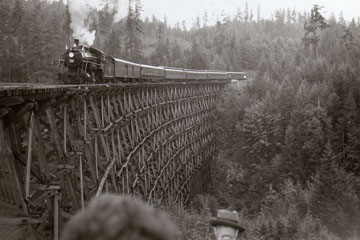Browse "Industry"
-
Article
Icewine
Canada didn’t invent icewine but in the space of a couple of decades it has become the Canadian product that is most sought after by the international wine community.
"https://d2ttikhf7xbzbs.cloudfront.net/media/media/b2b75291-9e2b-472e-8ef3-a3d6632e9111.jpg" // resources/views/front/categories/view.blade.php
https://d2ttikhf7xbzbs.cloudfront.net/media/media/b2b75291-9e2b-472e-8ef3-a3d6632e9111.jpg
-
Article
Canadian Imperial Bank of Commerce (CIBC)
The Canadian Imperial Bank of Commerce, commonly known as CIBC, is the fifth largest chartered bank in Canada. It was created through the 1961 merger of two Ontario-based banks, the Canadian Bank of Commerce and the Imperial Bank of Canada — the largest merger of two chartered banks in Canada’s history. Today, CIBC operates its business in Canada and abroad through three divisions: retail and business banking, wealth management, and capital markets. CIBC is a public company that trades on the Toronto Stock Exchange and the New York Stock Exchange under the symbol CM. In 2023, CIBC registered $23.3 billion in revenue and $5.0 billion in net income and held $975.72 billion in assets. The bank employs approximately 48,000 people, who serve 14 million clients around the world.
"https://d2ttikhf7xbzbs.cloudfront.net/media/media/43f7863d-e606-460c-a226-86ceb49f6896.jpg" // resources/views/front/categories/view.blade.php
https://d2ttikhf7xbzbs.cloudfront.net/media/media/43f7863d-e606-460c-a226-86ceb49f6896.jpg
-
Article
Canadian Journal of Economics and Political Science
Canadian Journal of Economics and Political Science was the academic journal of the Canadian Political Science Association, whose membership originally covered all the social sciences.
"https://development.thecanadianencyclopedia.ca/images/tce_placeholder.jpg?v=e9dca980c9bdb3aa11e832e7ea94f5d9" // resources/views/front/categories/view.blade.php
https://development.thecanadianencyclopedia.ca/images/tce_placeholder.jpg?v=e9dca980c9bdb3aa11e832e7ea94f5d9
-
Article
Canadian National Railway (CN)
Canadian National Railway Company, incorporated 6 June 1919, is the longest railway system in North America, controlling more than 31,000 km of track in Canada and the United States. It is the only transcontinental rail network in North America, connecting to three coasts: Atlantic, Pacific and Gulf of Mexico. Known as Canadian National (CN), the former Crown corporation expanded its holdings to include marine operations, hotels, telecommunications and resource industries. However, the core of CN was still its railway system, which had its origins in the amalgamation of five financially troubled railways during the years 1917–23: the Grand Trunk and its subsidiary, the Grand Trunk Pacific; the Intercolonial; the Canadian Northern; and the National Transcontinental. In 1995, CN was sold to private investors. CN is primarily a rail freight company and transports approximately $250 billion worth of goods annually. In 2016, it earned over $12 billion in revenue and employed over 22,000 people in Canada and the US.
"https://d2ttikhf7xbzbs.cloudfront.net/media/media/ffb48914-8c79-474f-ad6b-5edb6ccc0cc6.jpg" // resources/views/front/categories/view.blade.php
https://d2ttikhf7xbzbs.cloudfront.net/media/media/ffb48914-8c79-474f-ad6b-5edb6ccc0cc6.jpg
-
Article
Canadian Northern Railway
The Canadian Northern Railway started as a single Manitoba line of 84 miles (135 km) in 1896. In 1899, the railway received federal charter and was quickly developed by the railway entrepreneurs Sir William Mackenzie and Sir Donald Mann. By 1917, it had expanded to more than 9,000 miles (14,485 km) of track across seven provinces. Originally a major railway network over the Prairie provinces, the Canadian Northern Railway expanded into a transcontinental line with many supporting enterprises, including telegraph and steamship companies. (See also Railway History in Canada.)
"https://d2ttikhf7xbzbs.cloudfront.net/media/media/b1d9b093-5205-4fa7-9886-bf8da31e7062.jpg" // resources/views/front/categories/view.blade.php
https://d2ttikhf7xbzbs.cloudfront.net/media/media/b1d9b093-5205-4fa7-9886-bf8da31e7062.jpg
-
Editorial
Building the Canadian Northern Railway
The following article is an editorial written by The Canadian Encyclopedia staff. Editorials are not usually updated.
"https://d2ttikhf7xbzbs.cloudfront.net/media/media/e748f32b-1860-4bc4-b2b3-632a4370a944.jpg" // resources/views/front/categories/view.blade.php
https://d2ttikhf7xbzbs.cloudfront.net/media/media/e748f32b-1860-4bc4-b2b3-632a4370a944.jpg
-
Article
Canadian Pacific Railway
The Canadian Pacific Railway company (CPR) was incorporated in 1881. Its original purpose was the construction of a transcontinental railway, a promise to British Columbia upon its entry into Confederation (see Railway History). The railway — completed in 1885 — connected Eastern Canada to British Columbia and played an important role in the development of the nation. Built in dangerous conditions by thousands of labourers, including 15,000 Chinese temporary workers, the railway facilitated communication and transportation across the country. Over its long history, the Canadian Pacific Railway diversified its operations. The company established hotels, shipping lines and airlines, and developed mining and telecommunications industries (see Shipping Industry; Air Transport Industry). In 2001, Canadian Pacific separated into five separate and independent companies, with Canadian Pacific Railway returning to its origins as a railway company. CP, as it is branded today, has over 22,500 km of track across Canada and the United States. It is a public company and it trades on the Toronto Stock Exchange and the New York Stock Exchange under the symbol CP. In 2020, CP reported $7.71 billion in total revenues. This is the full-length entry about the Canadian Pacific Railway. For a plain-language summary, please see The Canadian Pacific Railway (Plain-Language Summary).
"https://d2ttikhf7xbzbs.cloudfront.net/media/media/c1bf1c65-a118-4b73-9ee5-5f9dccbd8ab8.jpg" // resources/views/front/categories/view.blade.php
https://d2ttikhf7xbzbs.cloudfront.net/media/media/c1bf1c65-a118-4b73-9ee5-5f9dccbd8ab8.jpg
-
Article
Canadian Press
Canadian Press (CP), Canada's principal news agency, began in 1910 as Canadian Press Ltd, a re-distributor of news from the Associated Press (AP) to Canadian newspapers through Morse code and telegraph wires.
"https://development.thecanadianencyclopedia.ca/images/tce_placeholder.jpg?v=e9dca980c9bdb3aa11e832e7ea94f5d9" // resources/views/front/categories/view.blade.php
https://development.thecanadianencyclopedia.ca/images/tce_placeholder.jpg?v=e9dca980c9bdb3aa11e832e7ea94f5d9
-
Macleans
Canadian Stones Transform Diamond Industry
WAWA, ONT., is a town known to cross-country hitchhikers as a cursed spot. They say you can be marooned here for days, dusty and morose on the side of the TransCanada, waiting for a lift.This article was originally published in Maclean's Magazine on September 8, 2003
"https://development.thecanadianencyclopedia.ca/images/tce_placeholder.jpg?v=e9dca980c9bdb3aa11e832e7ea94f5d9" // resources/views/front/categories/view.blade.php
https://development.thecanadianencyclopedia.ca/images/tce_placeholder.jpg?v=e9dca980c9bdb3aa11e832e7ea94f5d9
-
Article
Canadian Transportation Agency
The Canadian Transportation Agency, 1996, replaced the National Transportation Agency of Canada and is responsible for the economic regulation of carriers and modes of TRANSPORTATION under federal jurisdiction.
"https://development.thecanadianencyclopedia.ca/images/tce_placeholder.jpg?v=e9dca980c9bdb3aa11e832e7ea94f5d9" // resources/views/front/categories/view.blade.php
https://development.thecanadianencyclopedia.ca/images/tce_placeholder.jpg?v=e9dca980c9bdb3aa11e832e7ea94f5d9
-
Article
Canning
Canning, NS, incorporated as a village in 1968, population (2011c), 798 (2006c). The Village of Canning is located 100 km northwest of Halifax.
"https://development.thecanadianencyclopedia.ca/images/tce_placeholder.jpg?v=e9dca980c9bdb3aa11e832e7ea94f5d9" // resources/views/front/categories/view.blade.php
https://development.thecanadianencyclopedia.ca/images/tce_placeholder.jpg?v=e9dca980c9bdb3aa11e832e7ea94f5d9
-
Article
Canol Pipeline
Canol Pipeline, a 10 cm oil pipeline built from 1942 to 1944 from Norman Wells, NWT, 1000 km to a refinery at Whitehorse, Yukon.
"https://d2ttikhf7xbzbs.cloudfront.net/media/media/040a26ea-b068-46bd-adfb-98c5dadbcb07.JPG" // resources/views/front/categories/view.blade.php
https://d2ttikhf7xbzbs.cloudfront.net/media/media/040a26ea-b068-46bd-adfb-98c5dadbcb07.JPG -
Article
Canopy Growth Corporation
Canopy Growth Corporation was the first cannabis company in North America to be federally regulated and publicly traded. The Canadian company, headquartered in Smiths Falls, Ontario, produces a large portion of Canada’s legal cannabis flower, oils and edibles under its various brands. Its products are sold in all 13 Canadian provinces and territories. With more than two dozen subsidiaries and operations on five continents, Canopy is one of the world’s largest cannabis and hemp corporations. It employs 2,700 people full-time and is worth more than $20 billion.
"https://d2ttikhf7xbzbs.cloudfront.net/media/media/15a75b1f-63f9-44a5-a4b5-e145225ac9a7.jpg" // resources/views/front/categories/view.blade.php
https://d2ttikhf7xbzbs.cloudfront.net/media/media/15a75b1f-63f9-44a5-a4b5-e145225ac9a7.jpg
-
Article
Canwest Global Communications Corporation (Canwest Global)
Canwest Global was, until 2009, a diversified media conglomerate with properties in the broadcast, print, and online sectors of the industry, both in and outside of Canada.
"https://development.thecanadianencyclopedia.ca/images/tce_placeholder.jpg?v=e9dca980c9bdb3aa11e832e7ea94f5d9" // resources/views/front/categories/view.blade.php
https://development.thecanadianencyclopedia.ca/images/tce_placeholder.jpg?v=e9dca980c9bdb3aa11e832e7ea94f5d9
-
Macleans
CanWest's Dominant Newspaper Ownership
When Leonard Asper sits down with his morning papers, he doesn't read them just for the news, or to pick up the latest sports scores. Not any more.
"https://development.thecanadianencyclopedia.ca/images/tce_placeholder.jpg?v=e9dca980c9bdb3aa11e832e7ea94f5d9" // resources/views/front/categories/view.blade.php
https://development.thecanadianencyclopedia.ca/images/tce_placeholder.jpg?v=e9dca980c9bdb3aa11e832e7ea94f5d9

